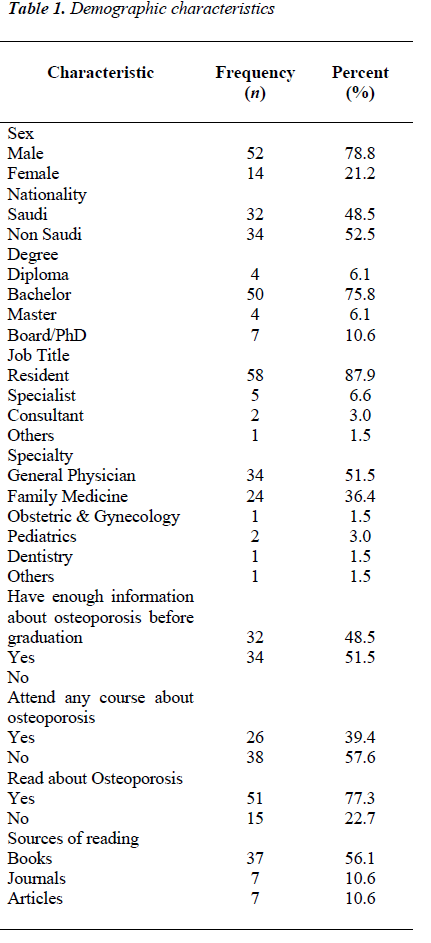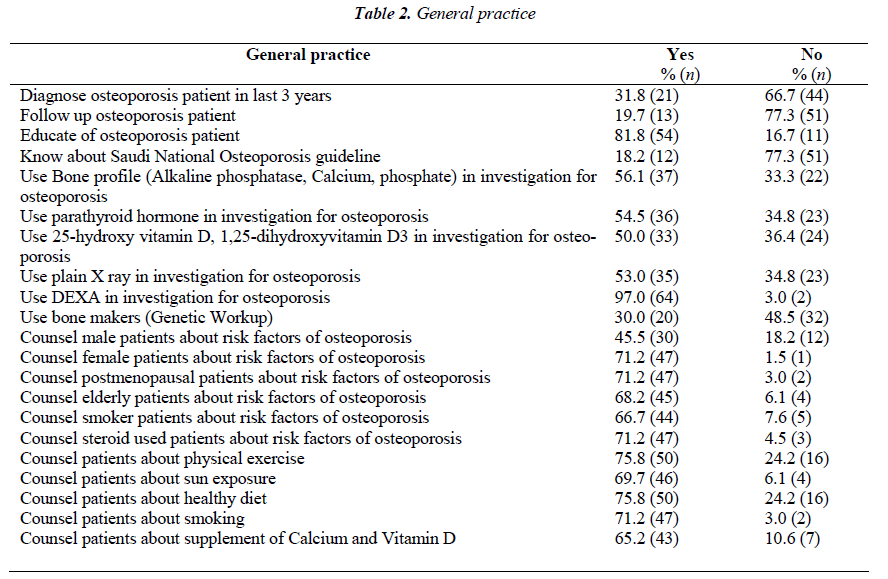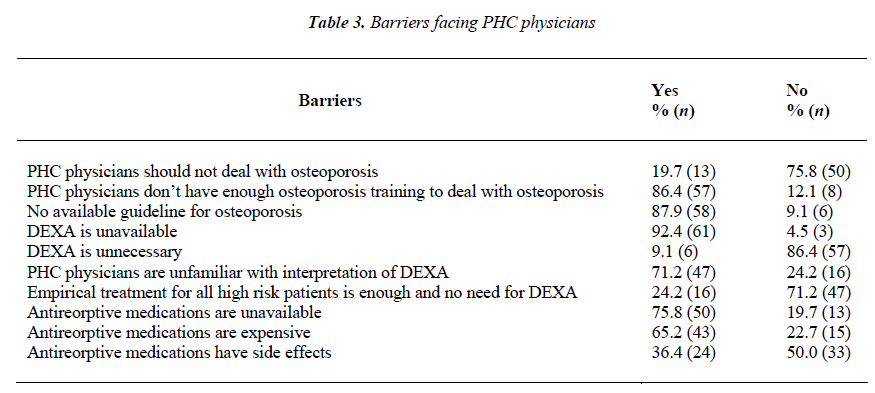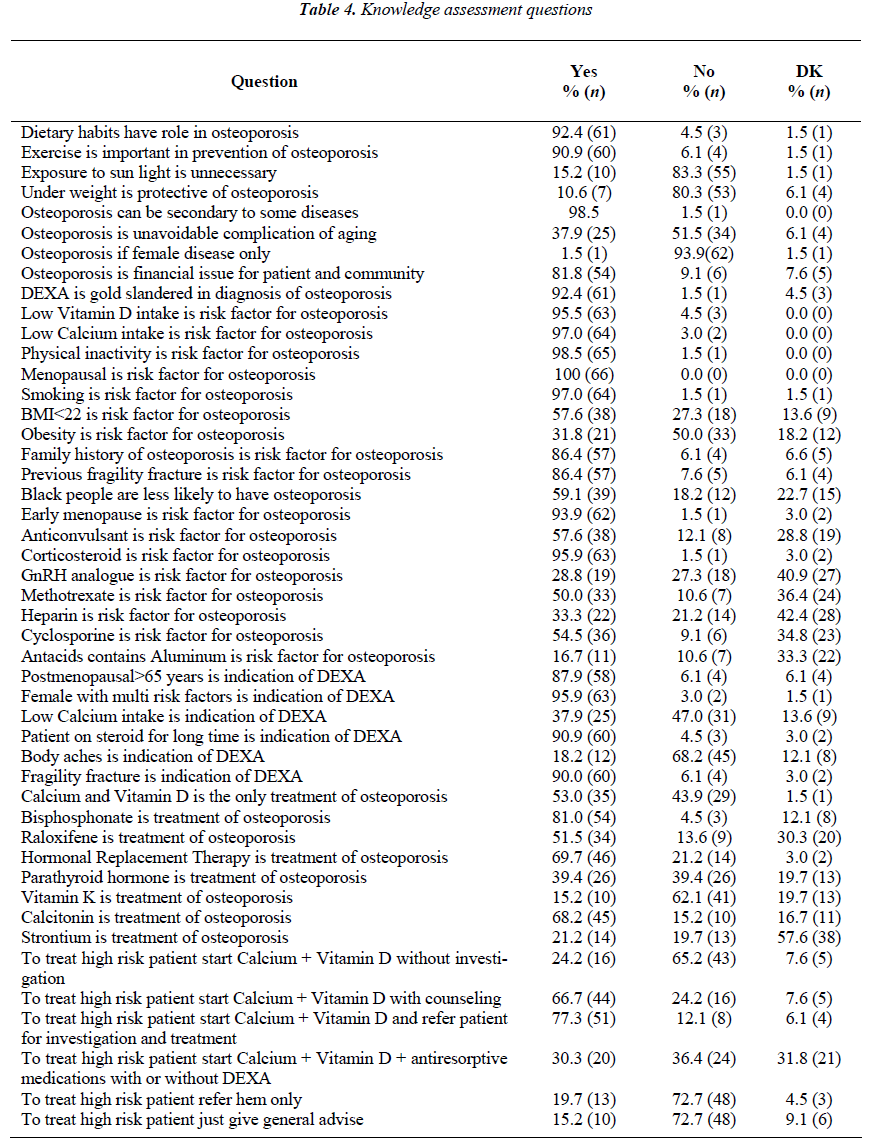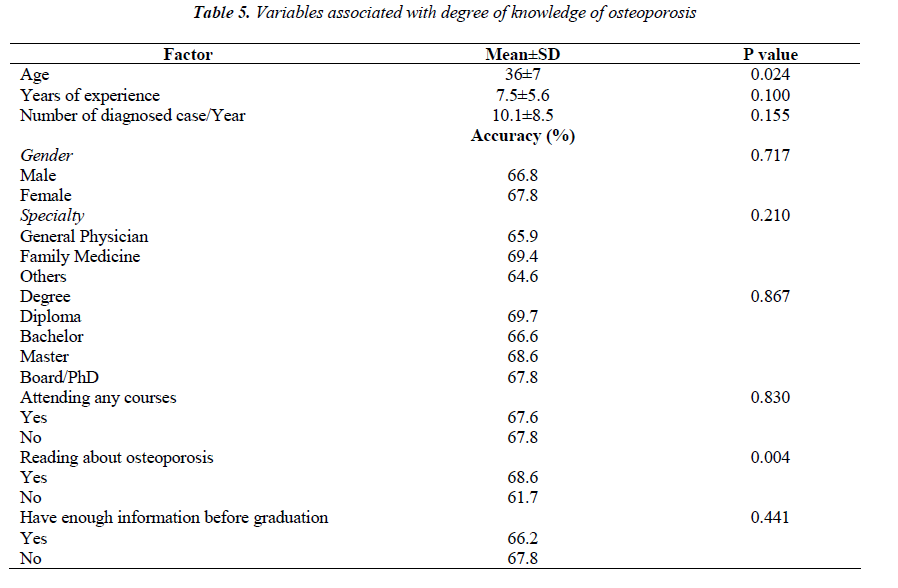- Biomedical Research (2013) Volume 24, Issue 4
Knowledge, practice and barriers in management of Osteoporosis.
Hassan Al-Musa*, Maha Alassmi, Areej AlMoria, Hamza Alghamdi, Salem Alfaifi.Department of Family and Community Medicine, College of Medicine, King Khalid University, Abha.
- *Corresponding Author:
- Hassan Mohammed Al-Musa
Family and Community Medicine Department
College of Medicine
King Khalid University, Abha
P.O. Box 641, Abha
Saudi Arabia
Accepted Date: May 27 2013
Citation: Al-Musa H, Alassmi M, AlMoria A, Alghamdi H, Alfaifi S. Knowledge, practice and barriers in management of Osteoporosis. Biomedical Research 2013; 24 (4):429-434.
Abstract
Osteoporosis is one of the commonest silent diseases leading to high morbidity and mortality. The challenge for Primary Health Care (PHC) physicians is to prevent, diagnose, and treat osteoporosis before fractures occur. The lack of knowledge about this disease is considered as an important barrier to appropriate risks identification and management of this common health problem. The objectives were to measure the knowledge of PHC physicians regarding osteoporosis, to determine their practice, and to identify the barriers facing them in management of osteoporosis. A cross sectional study using self-administered validated questionnaire distributed to all PHC physicians working in the Ministry of Health in Abha city was used. The questionnaire contains 47 questions to assess the knowledge. The level of knowledge was calculated as (number of correct answers/total answers×100). A 61% to 75%, and 76% to 85%, were considered as good knowledge and very good knowledge respectively while ≥ 86% was considered as excellent knowledge. Data were analyzed using Statistical Package for Social Sciences Version 20 (SPSS V.20). The response rate was 92%. A total of 66 PHC physicians were included in this study with mean age 36±7 years and 79% were males. A 52% were general physicians followed by 36% family physicians and 12% of other specialties. The main percentage of correct response was 67%. The percentage of correct response was significantly associated with age and reading about osteoporosis. Overall Knowledge was good in 54.5% and poor in 25.8% of participants. But the average overall score of knowledge was 67%, which is considered as good knowledge. Knowledge about risk factors was good in 50.0% of participant and excellent, very good and poor in 9.1%, 22.7% and 18.2% consecutively. Knowledge about DEXA indications was very good in 31.8%, excellent in 30.3%, good in 25.8% and it was poor in only 12.1% of participants. Knowledge about management of osteoporosis was poor in 62.1% of the participants and was good in 33.3% of participants and very good and excellent in only 1.5% and 3.0% consecutively. The high percent of poor knowledge about osteoporosis among PHC physicians needs more attention to find out the reasons and to improve the education and training of physicians especially about the management of this prevalent disease. Also, insignificant association between family medicine specialty and degree of knowledge about osteoporosis needs further improvement of family medicine program in Abha city.
Keywords
Primary Health Care Physicians, Osteoporosis, Practice, Diagnosis, Management
Introduction
Osteoporosis is defined as a systemic skeletal disease characterized by low bone mass and micro-architectural deterioration of bone tissue, with a consequent increase in bone fragility and susceptibility to fractures [1]. The clinical relevance of osteoporosis is derived not only from the increase in morbidity and mortality, but also the pain, physical impairment, and loss of functional ability that have an important impact on patients’ quality of life [2]. It also entails significant cost to society: hospitalization costs are increased as are medical tests, length of stay in nursing homes and consulting rooms, as well as the costs associated with patients’ diminished activity [3].
Osteoporosis currently affects more than 75 million in the USA, Europe and Japan [4]. In Saudi Arabia it was reported from different centers that the prevalence of postmenopausal Osteoporosis range between 50-70% [5].
In order to disseminate knowledge about osteoporosis, many international organizations developed guidelines to aid physicians in diagnosis and management of osteoporosis [6]. The role of general physicians in managing patients with osteoporosis has increased considerably so that researches in Australia and the United States had examined general physicians attitudes and knowledge regarding the diagnosis of osteoporosis and its management [7]. The aim of this study is to measure the knowledge of PHC physicians regarding osteoporosis, to determine their practice toward osteoporosis, and to identify the barriers facing them in management of osteoporosis.
Methodology
This is a cross sectional study using self-administered validated questionnaire divided into 4 parts; demographic characteristics, assessment of general practice toward osteoporosis, barriers facing physicians in dealing with osteoporosis and knowledge assessment by 47 questions about risk factors of osteoporosis, indications of Dualenergy X-ray absorptiometry (DEXA) and osteoporosis management. The information of the questionnaire was collected from well-published studies. The validity of the questionnaire was assessed by pilot study and it was reviewed by consultant endocrinologist, epidemiologist and family physician.
Questionnaires were distributed to all PHC physicians working in the Ministry of Health in Abha city. Data collected were analyzed using SPSS V20 software. The level of knowledge was calculated as (number of correct answers/ total answers×100).
Descriptive data were presented as frequencies and percentages. A 61% to 75% and 76% to 85% were considered as good knowledge and very good knowledge respectively while ≥ 86% was considered as excellent knowledge.
The association of the overall knowledge to independent variables was tested using T-test and ANOVA tests when applicable. A P value ≤ 0.05 was considered significant. This study was approved by directorate of health affairs at Aseer region and by the institutional review board at King Khalid University, College of Medicine Research Center.
Results
The response rate was 92%. A total of 66 PHC physicians (n= 66) were included in this study with mean age 36±7 years and mean period of experience 7.5±5.6 years. Other demographic characteristics are shown in Table 1.
The general practice of PHC physicians toward osteoporosis is summarized in Table 2.
Barriers toward diagnosis and management of osteoporosis by PHC physicians are shown in Table 3.
PHC physicians’ answers to the knowledge assessment questions are shown in Table 4.
With Regard to knowledge about osteoporosis, the mainpercentage of correct response in our study was 67% ± 8. The percentage of correct response was significantly associated with age and reading about osteoporosis but not with years of experience, number of cases diagnosed per year, gender, specialty, degree, attending osteoporosis’s courses and enough information before graduation as shown in Table 5.
The levels of knowledge are summarized in Table 6.
Discussion and conclusion
This study associated with educational efforts to sensitize PHC physician about the important of this topic. The most important barriers facing PHC physicians in our study recounted as physicians don’t have enough osteoporosis training to deal with osteoporosis, DEXA is unavail able and physicians are unfamiliar with interpretation of DEXA results, antireorptive medications are unavailable and no available guideline for osteoporosis. These barriers are similar to what was declared in literature, these barriers include lack of knowledge about osteoporosis and risk factors, inadequate training on osteoporosis during medical school, residencies and fellowships, unfamiliarity with screening guidelines, availability of and cost of- DEXA devices, lack of clarity in DEXA reports, failure to implement screening in appropriate populations, cost and possible adverse effects of medications [8-10].
More than 50% of physicians in our study don’t have enough information about osteoporosis before graduation and 86% don’t have enough post graduation training to deal with osteoporosis that is similar to UK physicians who considered the education on osteoporosis is inadequate and educational initiatives will be important both at undergraduate and postgraduate levels to increase awareness and knowledge of osteoporosis [11].
The main of correct response in our study was 67% compared to 63% in a cross-sectional survey of primary care practitioners in Spain [10]. In this survey, the percentage of correct responses was inversely associated with age and years of practice, and positively associated with specialty of community and family medicine while in our study the percentage of correct responses was significantly associated with age and reading about osteoporosis but not with family medicine specialty as was suspected form literature.
The high percent of poor knowledge about osteoporosis among PHC physicians needs more attention to find out the reasons and to improve the education and training of physicians especially about the management of this prevalent disease. Also, insignificant association between family medicine specialty and level of knowledge about osteoporosis need further improvement of family medicine program in Abha city.
References
- Moayyeri A, Soltani A, Tabari NK, Sadatsafavi M, Hossein-Neghad A, Larijani B. Discordance in diagnosis of osteoporosis using spine and hip bone densitometry. BMC endocrine disorders [Internet]. 2005 Mar 11 [cited 2012 Dec 1];5(1):3. Available from: http://www.biomedcentral.com/1472-6823/5/3
- Luz Rentero M, Carbonell C, Casillas M, González Béjar M, Berenguer R. Risk factors for osteoporosis and fractures in postmenopausal women between 50 and 65 years of age in a primary care setting in Spain: a questionnaire. The open rheumatology journal [Internet]. Bentham Science Publishers; 2008 Jan 10 [cited 2012 Dec 10];2:58–63. Available from: http://europepmc.org/abstract/MED/19088873
- Ray NF, Chan JK, Thamer M, Melton LJ. Medical expenditures for the treatment of osteoporotic fractures in the United States in 1995: report from the National Osteoporosis Foundation. Journal of bone and mineral research : the official journal of the American Society for Bone and Mineral Research [Internet]. 1997 Jan 1 [cited 2012 Dec 10];12(1):24–35. Available from: http://europepmc.org/abstract/MED/9240722
- Kanis JA. New osteoporosis guidelines for Canada. CMAJ : Canadian Medical Association journal = journal de l’Association medicale canadienne [Internet]. 2010 Nov 23 [cited 2012 Dec 10];182(17):1829–1830. Available from: http://www.cmaj.ca/content/182/17/1829.full
- Miros Sadat-Ali, Ibrahime M Al-Habdan, Fatma A Al- Mulhim, Abdallah Y El-Hassan. Bone mineral density among postmenopausal Saudi women. Saudi Medical Journal [Internet]. 2004 [cited 2012 Dec 10];25(11):- 1623-1625. Available from: http://www.smj.org.sa/-DetailArticle.asp?ArticleId=2132.
- Werner P, Vered I. Management of osteoporosis: A survey of Israeli physicians’ knowledge and attitudes. The Israel Medical Association journal : IMAJ [Internet]. 2000 May [cited 2012 Dec 10];2(5):361– 364. Available from: http://www.ncbi.nlm.nih.gov/pubmed/10892390
- Chenot R, Scheidt-Nave C, Gabler S, Kochen MM, Himmel W. German primary care doctors’ awareness of osteoporosis and knowledge of national guidelines. Experimental and clinical endocrinology & diabetes : official journal, German Society of Endocrinology [and] German Diabetes Association [Internet]. © J. A. Barth Verlag in Georg Thieme Verlag KG · Stuttgart · New York; 2007 Oct 18 [cited 2012 Dec 10];115(9):584–589. Available from: https://www.thieme-connect.com/DOI/DOI?10.1055/s-2007-981454
- Module 1 - Osteoporosis Management: Introduction, Obstacles, Assessing Risk Factors [Internet]. Available from: http://stg.centrax.com/ama/osteo/part4/module01/index.htm
- Kaufman JD, Bolander ME, Bunta AD, Edwards BJ, Fitzpatrick LA, Simonelli C. Barriers and solutions to osteoporosis care in patients with a hip fracture. The Journal of bone and joint surgery. American volume [Internet]. 2003 Sep [cited 2012 Dec 19];85- A(9):1837–1843. Available from: http://www.ncbi.nlm.nih.gov/pubmed/12954849
- Pérez-Edo L, Ciria Recasens M, Castelo-Branco C, Orozco López P, Gimeno Marqués A, Pérez C, et al. Management of osteoporosis in general practice: a cross-sectional survey of primary care practitioners in Spain. Osteoporosis international : a journal established as result of cooperation between the European Foundation for Osteoporosis and the National Osteoporosis Foundation of the USA [Internet]. 2004 Mar [cited 2012 Dec 19];15(3):252–257. Available from: http://www.ncbi.nlm.nih.gov/pubmed/14745487
- Taylor JC, Sterkel B, Utley M, Shipley M, Newman S, Horton M, et al. Opinions and experiences in general practice on osteoporosis prevention, diagnosis and management. Osteoporosis international : a journal established as result of cooperation between the European Foundation for Osteoporosis and the National Osteoporosis Foundation of the USA [Internet]. 2001 Jan [cited 2012 Dec 19];12(10):844–848. Available from: http://www.ncbi.nlm.nih.gov/pubmed/11716187
